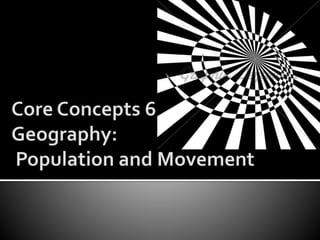Population and movement
•Download as PPTX, PDF•
0 likes•487 views
Report
Share
Report
Share

Recommended
Recommended
More Related Content
What's hot
What's hot (19)
AS Level Human Geography - Migration of Population 

AS Level Human Geography - Migration of Population
Viewers also liked
Viewers also liked (8)
5th Grade Ch 9 Lesson 1 What Is The Structure Of Earth

5th Grade Ch 9 Lesson 1 What Is The Structure Of Earth
Similar to Population and movement
Similar to Population and movement (20)
The world population distribution, density and growth

The world population distribution, density and growth
Population Growth And Environmental Challenges of Cities

Population Growth And Environmental Challenges of Cities
Trends, Network and Critical Thinking Unit 3 Global Networks Labor and Migration

Trends, Network and Critical Thinking Unit 3 Global Networks Labor and Migration
More from RhondaUding
More from RhondaUding (7)
Recently uploaded
Recently uploaded (20)
Event-Driven Architecture Masterclass: Engineering a Robust, High-performance...

Event-Driven Architecture Masterclass: Engineering a Robust, High-performance...
The Value of Certifying Products for FDO _ Paul at FIDO Alliance.pdf

The Value of Certifying Products for FDO _ Paul at FIDO Alliance.pdf
How Red Hat Uses FDO in Device Lifecycle _ Costin and Vitaliy at Red Hat.pdf

How Red Hat Uses FDO in Device Lifecycle _ Costin and Vitaliy at Red Hat.pdf
Breaking Down the Flutterwave Scandal What You Need to Know.pdf

Breaking Down the Flutterwave Scandal What You Need to Know.pdf
Your enemies use GenAI too - staying ahead of fraud with Neo4j

Your enemies use GenAI too - staying ahead of fraud with Neo4j
Introduction to FDO and How It works Applications _ Richard at FIDO Alliance.pdf

Introduction to FDO and How It works Applications _ Richard at FIDO Alliance.pdf
Linux Foundation Edge _ Overview of FDO Software Components _ Randy at Intel.pdf

Linux Foundation Edge _ Overview of FDO Software Components _ Randy at Intel.pdf
Long journey of Ruby Standard library at RubyKaigi 2024

Long journey of Ruby Standard library at RubyKaigi 2024
ASRock Industrial FDO Solutions in Action for Industrial Edge AI _ Kenny at A...

ASRock Industrial FDO Solutions in Action for Industrial Edge AI _ Kenny at A...
Continuing Bonds Through AI: A Hermeneutic Reflection on Thanabots

Continuing Bonds Through AI: A Hermeneutic Reflection on Thanabots
Where to Learn More About FDO _ Richard at FIDO Alliance.pdf

Where to Learn More About FDO _ Richard at FIDO Alliance.pdf
TEST BANK For, Information Technology Project Management 9th Edition Kathy Sc...

TEST BANK For, Information Technology Project Management 9th Edition Kathy Sc...
Easier, Faster, and More Powerful – Notes Document Properties Reimagined

Easier, Faster, and More Powerful – Notes Document Properties Reimagined
Intro to Passkeys and the State of Passwordless.pptx

Intro to Passkeys and the State of Passwordless.pptx
Population and movement
- 2. ▪ Students will demonstrate the following enduring understanding ▪ Population growth can have both short- term and long-term economic and environmental effects on a place. ▪ People choose to settle in areas that meet their basic needs. ▪ Migration takes place when people decide that their needs can be better met in a different location.
- 4. Today, the world’s population is around 7 billion. When people first began farming around 12,000 years ago, it was fewer than 10 million. Since then, better food production and healthcare have caused a population boom.
- 5. Demographers are scientist who study human populations. They measure the rate at which population is growing. They compare birth rates to death rates. The birth rate is the number of live births per 1,000 people in a year. The death rate is the number of deaths per 1,000 people per year.
- 6. The Industrial Revolution brought many changes to the population growth. Medical Care Improvements in food production Living conditions
- 7. Population growth has positive and negative effects. ▪ For example, a growing population can produce more goods and services. However a rapid growth can also cause problems. The population can grow faster than the supply of food, water, medicine and other resources.
- 8. Population distribution is the spreading of people over an area of land. The world’s population is distributed unevenly on Earth’s surface. People try to live in places that meet their basic needs. Population density is the number of people per unit of land area.
- 9. For thousands of years, people have migrated to new places. Migration is the movement of people from one place to another.
- 10. People often migrate within a country. When you migrate from one place of the country to another place in the country it is known as internal migration. Moving from one country to another country is known as external migration.
- 11. When people leave their country, they emigrate, which means to migrate out of a place. To enter a new country is to immigrate, or to migrate into a place.
- 12. People who migrate are often looking for a better life. They may move to escape poverty, a lack of jobs, or a harsh climate. In some countries, war or other conflicts forces people to migrate. These reasons for migration are known as push factors. Push factors are causes of migration that push people to leave their home country. Other reasons are known as Pull factors. Freedom, supply of jobs are pull factors.
- 13. In many parts of the world people are migrating from rural areas to urban areas. Urban areas are cities. Rural areas are settlements in the country. Urbanization is the movement of people from rural areas to urban areas.
- 14. Rapid urbanization has created challenges for growing cities, especially those in poor countries. These cities cannot provide the housing, school, jobs and other services. ▪ Resulting in slums, or poor overcrowded urban areas. Wealthier countries deal with Suburban sprawl. Suburban sprawl is the spread of suburbs away fro the core city.